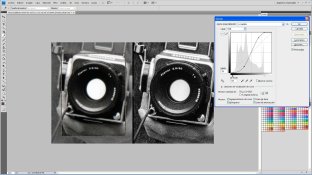Of course, but a lens resolving 300MPix effective in a 5.9" frame, in macro conditions, this is a fine lens working at optimal magnification, no doubt. I'm used to check performance of MF and LF lenses in macro conditions, belive me, a 300MPix in 5.9" projection is a really fine lens.
A lens of this quality would cost a lot if sold as retail photographic grear, try to buy two new lenses like those in a V700 and you will see that cost can be several times the price of a V850, but you know... industrial components mass produced have a 1/15 of the retail price or less.
Several false staments and lies have been thrown by Epson haters about the V700 glass, some were saying that lenses were bad plastic... At first I believed this lie, but when I saw that it optically resolved 2900pix over a 150mm field then I found that it was a coarse lie.
300 MP for what is essentially a large format macro lens is not very good.
It sure AF doesn't get anything close to everything out of a 4x5 or 8x10.
You argument continues to be essentially "but it's Good Enough ™".
Well, it's not.
Even with a relatively modest print like Carvers in the OP you'll see a clear difference.
We are not talking nit picking and being anal retentive, obsessive compulsive, Asperger like, autistically obsessed with minute differences.
These are big and obvious differences, once you don't view the photos 1:1 on a screen.
A big part of of having a print on the wall is walking up close to it, to suck in all the detail and atmosphere in that detail.
I'm all for the low resolution aesthetic. I use halfframe all the time. Hell, I'd be using Minox if I could be arsed to get a cutter.
I get it.
But when you shoot larger formats and good, fine grain film, you
want a high resolution result!
Sharpening is not the answer because:
A: You could of course do the exact same sharpening to the higher resolution scan, and get a better result.
More information
is better. You can't invent something that is not there,
B. The Epson scans react poorly to sharpening. The false grain structure will get blown up, or even be mistaken for real objects in the frame by an "intelligent" sharpening tool.
All the amateur tests are fine. But we can't be sure of their conditions and stringency.
"Did they really get the focus right in the source?".
"How was their scanning technique and was the scanner calibrated?".
"What kind of PP did they actually use and what kind of PP where they not aware of being automatic?".
"Are they lying?".
"Do they actually have an agenda, even without perhaps being fully aware of it themselves?".
Etc.







